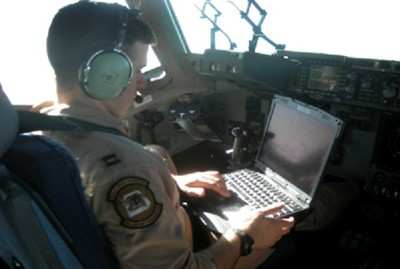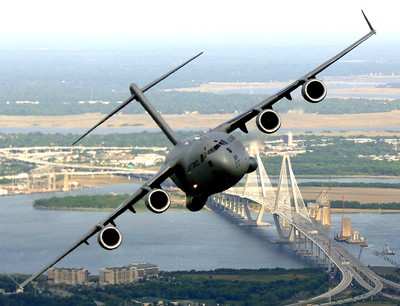Tue, Jul 12, 2011
Fuel Economies Of Up To 1.5 Percent Are Predicted
This summer, C-17 crews will start saving more gas by using
Mission Index Flying -- a new program that allows them to adjust
their flight profile in real-time in order to maximize fuel
efficiency while meeting mission objectives. The mobility air force
enterprise expects to see a 1.25 to 1.5 percent decrease in fuel
usage across the C-17 fleet, said Lt. Col. Marc Gildner, Air
Mobility Command Fuel Efficiency Office.

USAF Photo
"It doesn't seem like much. But because
Mobility Air Forces use almost 60 percent of the total Air Force
fuel inventory, that is a considerable dollar figure which can be
used to recapitalize the aging fleet, support fuel efficiency
initiatives and provide resources for incentives," Colonel Gildner
said.
Mission index flying was approved June 15 for use on the C-17
fleet, with aircrew training expected to be complete by the end of
the summer. The C-5 fleet is next, with fielding expected in late
July and aircrew training complete by early fall. The KC-10 and
KC-135 systems are being prepared for AMC testing and will be
fielded in the fall as well, Colonel Gildner said.

To use Mission Index Flying, air crews input various flight and
atmospheric parameters on a mission laptop at different intervals
during a mission, and the software provides them with speed and
altitude recommendations for maximum aircraft performance and
efficiency. While Mission Index Flying is new for AMC, it isn't a
new concept. Cost Index Flying (the commercial equivalent of
Mission Index Flying) has helped airlines manage bottom lines for
over a quarter of a century. "The airlines have realized increased
fuel efficiencies because they have been using this concept for
almost three decades," Colonel Gildner said. "We're trying to
capitalize and leverage their technologies and capabilities to our
benefit."
In the future, Mobility Air Force says it could use Mission
Index Flying to refine results for other efficiencies as well. Cost
Index Flying is used operationally by the commercial airline
industry to balance operational costs to fuel costs, Colonel
Gildner said. Operational costs include maintenance, labor,
over-flight fees, etc. These operational costs are examined to
determine their impact on overall flight costs per hour and then
balanced with fuel costs to provide the big picture, said Lt. Col
Eric Lepchenske, AMC Fuel Efficiency Office.
More News
Circle To Runway (Runway Number) Used by ATC to inform the pilot that he/she must circle to land because the runway in use is other than the runway aligned with the instrument appr>[...]
Aero Linx: National Aviation Safety Foundation (NASF) The National Aviation Safety Foundation is a support group whose objective is to enhance aviation safety through educational p>[...]
At Altitude Of About 250-300 Ft Agl, The Airplane Experienced A Total Loss Of Engine Power On November 6, 2024, at 1600 central standard time, a De Havilland DHC-1, N420TD, was inv>[...]
From 2009 (YouTube Edition): Three Hour Flight Was 'Flawless' -- At Least, Until Mother Nature Intervened For anyone who loves the aviation business, this was a VERY good day. Afte>[...]
Also: AMA Names Tyler Dobbs, More Falcon 9 Ops, Firefly Launch Unsuccessful, Autonomous F-16s The Air Force has begun ground testing a future uncrewed jet design in a milestone tow>[...]
 ANN's Daily Aero-Term (05.05.25): Circle To Runway (Runway Number)
ANN's Daily Aero-Term (05.05.25): Circle To Runway (Runway Number) ANN's Daily Aero-Linx (05.05.25)
ANN's Daily Aero-Linx (05.05.25) NTSB Prelim: De Havilland DHC-1
NTSB Prelim: De Havilland DHC-1 Classic Aero-TV: The Boeing Dreamliner -- Historic First Flight Coverage
Classic Aero-TV: The Boeing Dreamliner -- Historic First Flight Coverage Airborne-NextGen 05.06.25: AF Uncrewed Fighters, Drones v Planes, Joby Crew Test
Airborne-NextGen 05.06.25: AF Uncrewed Fighters, Drones v Planes, Joby Crew Test




